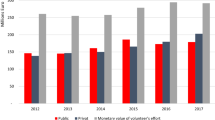Abstract
The purpose of this article is to explain the cross-sectional variation in money donations to charities at the organizational level. Using a unique data base which includes volunteer labor data, this article tests the hypotheses that money donations are positively related to volunteering and the technical efficiency of the firm. Technical efficiency is measured by a number of non-parametric indices. The empirical results indicateinter alia that the more technically efficient the charity, the more money donations it is able to raise. Moreoer, at least for one model, money donations and volunteering are found to be complementary at the organizational level. In addition, the results in this article are not consistent with the well-known hypothesis that government financing crowds out private donations.
Similar content being viewed by others
References
Ali, A.A. and L.M. Seiford, (1993). “The Mathermatical Programming Approach to Efficiency Analysis,” InThe Measurement of Productive Efficiency, (H.O. Fried, C.A. Knox Lovell, and S.S. Schmidt, eds.), Oxford University Press, Oxford: 120–159.
R.D. Banker. (1993). “Maximum Likelihood, Consistency, and Data Envelopment Analysis.”Management Science, 39, 1265–1273.
R.D. Banker, A. Charnes and W.W. Cooper. (1984). “Some Models for Estimating Technical and Scale Inefficiencies in Data Envelopment Analysis.”Management Science 30, 1078–1092.
R. D. Banker, A. Charnes, W.W. Cooper, J. Swarts and D. Thomas. (1989). “An Introduction to Data Envelopment Analysis with Some of its Models and Their Uses.”Research in Governmental and Nonprofit Accounting 5, 25–64.
R.D. Banker, S. Das, and S.M. Datar (1989). “Analysis of Cost Variances for Management Control in Hospitals,”Research in Governmental and Nonprofit Accounting 5, 269–291.
J. Boles (1966). “Efficiency Squared: Efficient Computations of Efficiency Indexes.”Western Farm Economics Association Proceedings, 137–142.
J.L. Callen (1991). “Data Envelopment Analysis: Partial Survey and Applications for Management Accounting.”Journal of Management Accounting Research 3, 35–56.
J.L. Callen and H. Falk (1993). “Agency and Efficiency in Nonprofit Organizations: The Case of “Specific Health Focus” Charities.”The Accounting Review 68, 48–65.
A. Charnes, W.W. Cooper and E. Rhodes. (1978). “Measuring the Efficiency of Decision Making Units.”European Journal of Operational Research 2, 429–444.
C.T. Clotfelter. (1985).Tax Incentives and Charitable Giving. Chicago: University of Chicago Press.
M.J. Farrell. (1957). “The Measurement of Productive Efficiency.”Journal of the Royal Statistical Society Series A, General, 120, 253–290.
L.G. Godfrey, M. McAleer, and C.R. McKenzie. (1988). “Variable Addition and Lagrange Multiplier Tests for Linear and Logarithmic Regression Models.”Review of Economics and Statistics 70, 492–503.
W.H. Green. (1993). “The Econometric Approach to Efficiency Analysis.” InThe Measurement of Productive Efficiency, (H.O. Fried, C.A. Knox Lovell, and S.S. Schmidt, eds.) Oxford: Oxford University Press, 68–119.
H.B. Hansmann. (1980). “The Role of Nonprofit Enterprise.”The Yale Law Journal 8, 835–898.
P.L. Menchik and B.A. Weisbrod. (1978). “Volunteer Labor Supply.”Journal of Public Economics 32, 159–183.
J. Posnett and T. Sandler. (1989). “Demand for Charity Donations in Private Nonprofit Markets.”Journal of Public Economics 40, 187–200.
P. Schmidt (1985–1986). “Frontier Production Functions.”Econometric Reviews 4, 289–328.
L.M. Seiford and R.M. Thrall (1990). “Recent Developments in DEA: The Mathematical Programming Approach to Frontier Analysis.”Journal of Econometrics 46, 7–38.
C.E. Shepard (1992). “Perks, Privileges and Power in the Nonprofit World.”Washington Post (February 16): A1, A38.
R. Steinberg (1986). “Should Donors Care about Fundraising?” InThe Economics of Nonprofit Institutions, (S. Rose-Ackerman ed.) New York: Oxford University Press, 346–364.
The Third Sector Directory Donor's Guide to Fund Raising, (1988). Third Sector Publishing, Toronto, Canada.
B.A. Weisbrod, and N.D. Dominguez. (1986). “Demand for Collective Goods in Private Nonprofit Markets: Can Fundraising Expenditures Help Overcome Free-riding Behavior?”Journal of Public Economics 30, 83–95.
H. White. (1980). “A Heteroskedasticity-consistent Covariance Matrix Estimator and a Direct Test for Heteroskedasticity.”Econometrica 48, 817–838.
Author information
Authors and Affiliations
Rights and permissions
About this article
Cite this article
Callen, J.L. Money donations, volunteering and organizational efficiency. J Prod Anal 5, 215–228 (1994). https://doi.org/10.1007/BF01073908
Issue Date:
DOI: https://doi.org/10.1007/BF01073908




